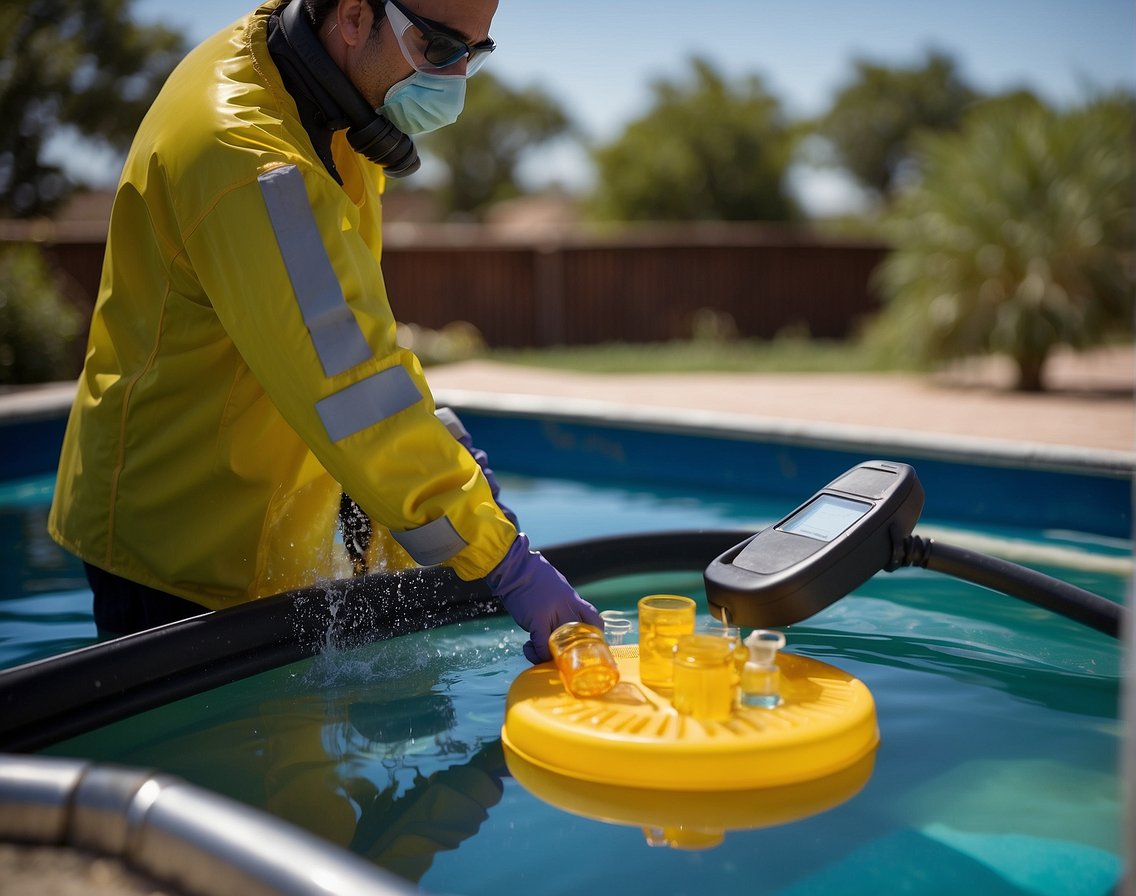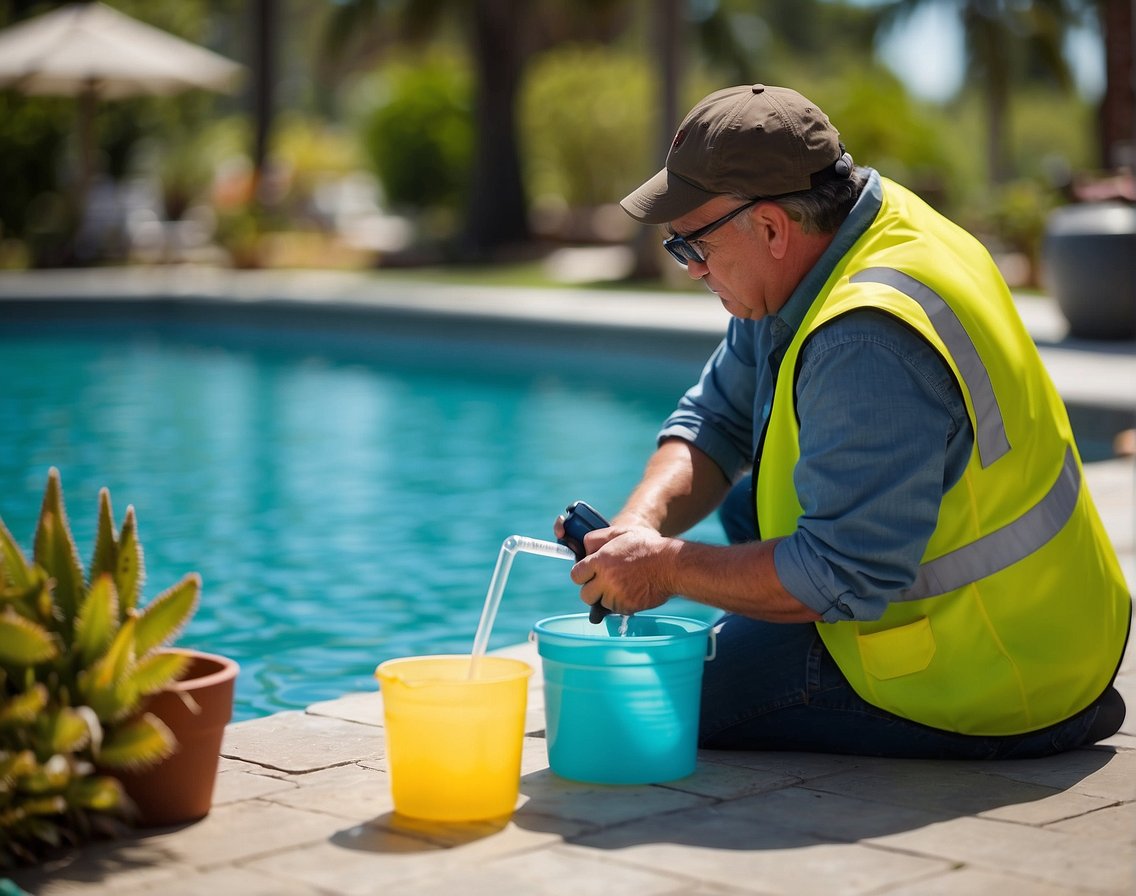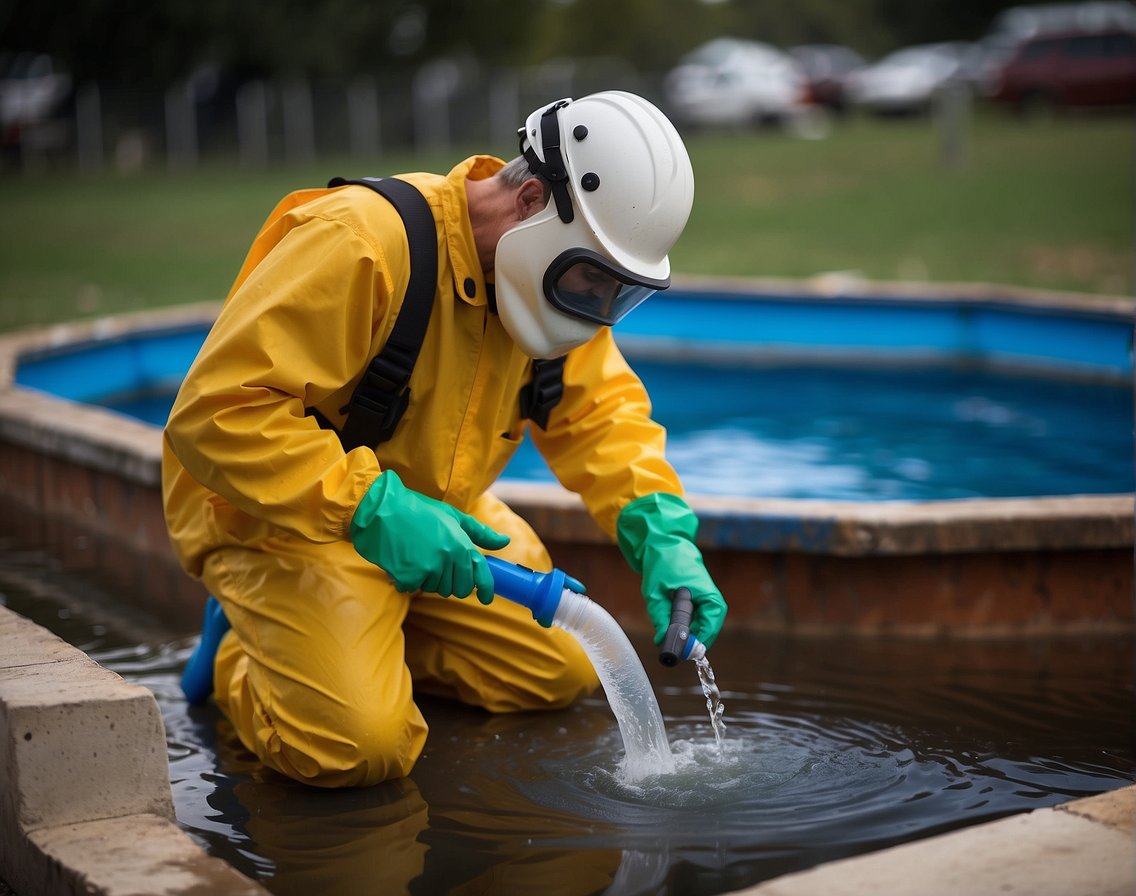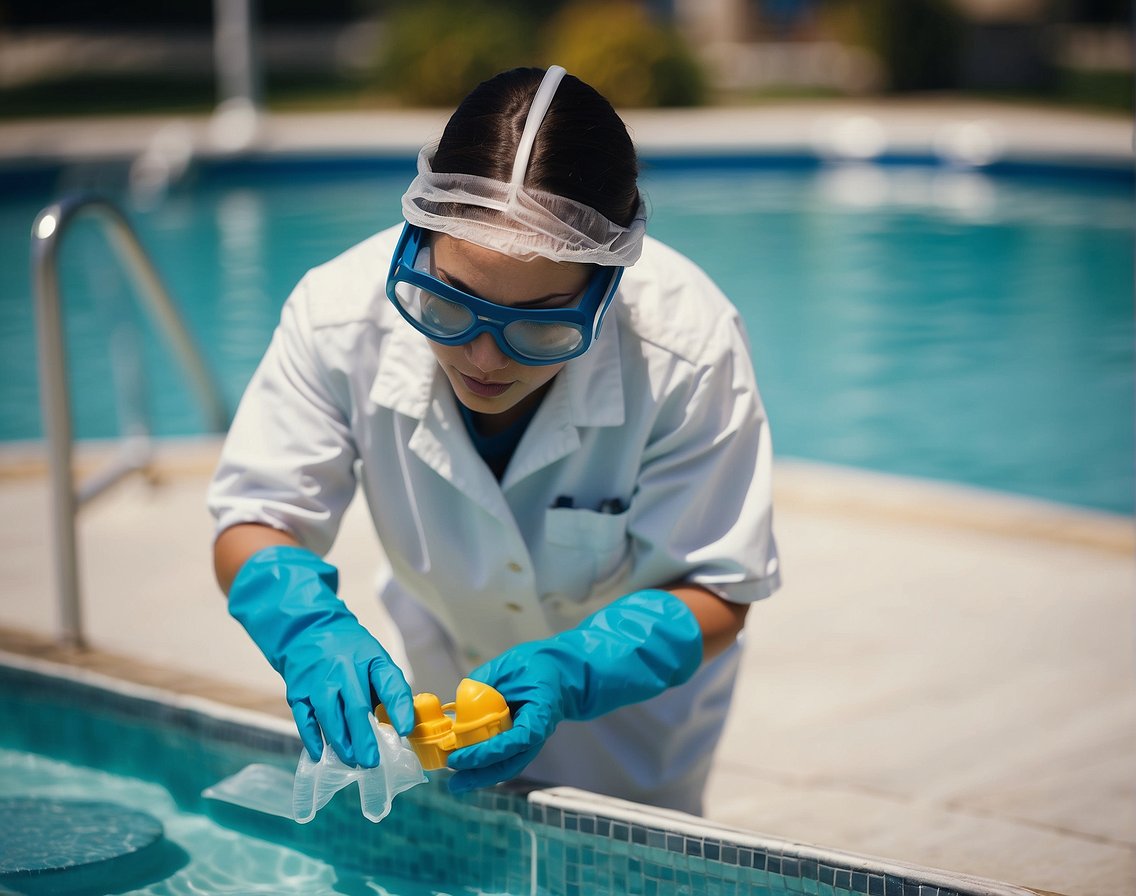Understanding Pool Chemistry
We must maintain proper pool water chemistry to ensure the safety and longevity of our pool. This involves regular testing and balancing of various chemical levels. pH, total alkalinity, and calcium hardness are the key players in pool chemistry.
pH Levels
The pH scale measures how acidic or basic our pool water is. We aim for a pH level between 7.2 and 7.8, which is comfortable for swimmers and helps sanitizer work effectively.
- Ideal range: 7.2 – 7.8
Total Alkalinity(TA)
Total alkalinity serves as a buffer for pH, preventing drastic swings in acidity or basicness. The correct range for TA helps maintain stable pH levels.
- Ideal range: 80 – 120 ppm
Calcium Hardness
Calcium hardness is the measure of how hard or soft our water is. Keeping an optimal level prevents damage to the pool surface and equipment.
- Ideal range: 200 – 400 ppm
We must test our pool water regularly, ideally weekly, to ensure these parameters remain within their ideal ranges. Common chemicals we use include pH increasers or decreasers, alkalinity increasers, and calcium hardness increasers. It’s crucial to follow the manufacturer’s instructions and add chemicals directly to the pool or dilute them as recommended, all while the pump is running to distribute them evenly.
For example, to adjust pH:
- Increase pH: Add sodium carbonate (soda ash)
- Decrease pH: Add sodium bisulfate or muriatic acid
| Chemical | Function | Ideal Range |
|---|---|---|
| pH | Acidity/Basicity | 7.2 – 7.8 |
| Total Alkalinity (TA) | pH Buffer | 80 – 120 ppm |
| Calcium Hardness | Water Hardness | 200 – 400 ppm |
Lastly, we always handle chemicals with care, store them in a cool, dry place, and never mix them.
Maintaining Proper Sanitization

Proper pool sanitization is crucial to ensure the safety and cleanliness of the swimming environment. We focus on adjusting chlorine levels and using algaecides and sanitizers to keep bacteria, algae, and other contaminants at bay.
Adjusting Chlorine Levels
Chlorine is the primary sanitizer used in pool maintenance. Adjusting the chlorine levels correctly is essential for disinfecting water and eliminating harmful germs and viruses. We recommend maintaining chlorine levels between 1-3 ppm (parts per million) for optimal sanitization.
Daily Chlorine Check:
- Test water using test strips or a liquid test kit.
- Add chlorine to increase levels if below 1 ppm.
- Reduce chlorine if levels exceed 3 ppm by diluting the pool water.
To stabilize chlorine and reduce its degradation from UV light, we incorporate cyanuric acid into the water. Maintain cyanuric acid levels between 30-50 ppm to ensure that the chlorine remains effective longer.
Using Algaecides and Sanitizers
Besides chlorine, other pool chemicals play a role in combating contaminants. Algaecide is specifically used to prevent and eliminate algae growth.
Effective Algaecide Use:
- Apply algaecide according to manufacturer’s instructions.
- Apply after shock treatments when chlorine levels normalize.
For pools where chlorine use is limited or not preferred, bromine serves as an effective alternative sanitizer. It’s essential in reducing chlorine odors and irritations, but works similarly to chlorine in killing bacteria and viruses.
Non-Chlorine Sanitizing Steps:
- Test water to ensure proper pH levels.
- Calculate the appropriate amount of bromine needed for your pool size.
- Add bromine tablets to a floater or feeder to distribute evenly.
Remember to regularly check and balance your pool’s chemistry to sustain a healthy and sanitized swimming environment.
Regulating Water Balance
Maintaining a balanced water chemistry is essential for a safe and enjoyable swimming environment. We need to pay close attention to key parameters such as pH levels and alkalinity, as well as calcium and hardness to prevent issues like scaling.

Correcting pH and Alkalinity
pH Levels: Optimal pool pH levels should be between 7.4 and 7.6. If the pool water is acidic (below 7.4), we use soda ash (sodium carbonate) to raise the pH. Conversely, if the water is too basic (above 7.6), sodium bisulfate or muriatic acid can be added to lower it.
Alkalinity: A target alkalinity range of 100-150 parts per million (ppm) supports stable pH levels. To increase alkalinity, sodium bicarbonate is our go-to chemical. Decreasing alkalinity is achieved by cautiously adding muriatic acid or sodium bisulfate, while keeping a close eye on the pH, as these chemicals will also affect it.
Managing Calcium and Hardness
Calcium Hardness
We aim for calcium hardness levels in the range of 200-400 ppm to prevent the water from becoming corrosive or causing scaling. To raise the level of calcium, calcium chloride is added to the pool.
Preventing Scaling
Regular testing and balancing of calcium hardness are crucial. Scaling can occur when calcium levels are too high, and it manifests as a white crusty deposit on the pool surfaces. To manage this, we ensure that the water chemistry is balanced, particularly focusing on maintaining correct calcium hardness levels.
Operational Best Practices

Maintaining proper chemical balance and ensuring safety in a pool environment are crucial for us as pool professionals and owners. By consistently applying operational best practices, we safeguard the health of swimmers and prolong the lifespan of pool equipment.
Routine Testing and Adjustment
Testing is an integral part of pool maintenance. We follow a strict testing method to evaluate the chemical composition of the water frequently and make adjustments accordingly.
- Frequency: Test water at least twice a week during peak usage and weekly during off-peak periods.
- Method: Utilize reliable testing kits or digital equipment for accurate results.
- Parameters: Balance pH, chlorine, alkalinity, calcium hardness, and stabilizer levels.
- Documentation: Keep a pool care checklist to track changes and trends over time.
Safety in Handling and Storing Chemicals
When handling and storing pool chemicals, we adopt rigorous safety measures to prevent accidents and injuries.
Personal Protective Equipment (PPE)
- Always wear gloves, goggles, and protective clothing.
Chemical Handling
- Read and follow label instructions carefully.
- Never mix chemicals, especially chlorine and acid.
- Pre-dissolve chemicals separately when required by the manufacturer.
Storage Best Practices
- Keep chemicals in a cool, dry, and well-ventilated area.
- Store different chemicals separately to avoid reactions.
It’s essential for us to train all personnel involved in pool maintenance on these safety protocols to uphold the highest standards of chemical safety.
Troubleshooting Common Pool Problems

In maintaining high water quality, we often face issues such as cloudy or green water and high chemical levels. It’s our job to identify and correct these problems promptly.
Remedying Cloudy or Green Water
Cloudy water in pools is typically a result of fine debris, algae growth, or imbalances in the pool’s chemistry. To clear it, first ensure that our pool filter is running properly and is not clogged. For algae-induced green water, we’ll need to use an algaecide and ensure chlorine levels are adequate. Next, apply a shock treatment to eradicate any invisible bacteria or algae spores. Lastly, utilizing flocculants can help by gathering the particles together, allowing them to sink to the bottom for easy vacuuming.
Dealing with High Chemical Levels and Contamination
When we encounter high chemical levels, like chlorine or pH, immediate action is crucial to prevent skin and eye irritation. For high chlorine, expose the pool to sunlight, which naturally lowers chlorine levels, or add a chlorine neutralizer. For high pH levels, we can add dry acid to lower it. It’s vital that we tackle contaminants like dirt, oils, and bacterias quickly:
- Regularly test and balance chemical levels.
- Clean and backwash the pool filter to ensure contaminants are removed efficiently.
- Encourage swimmers to shower before entering to reduce oil and dirt introduction.
Frequently Asked Questions
Adding pool chemicals in the correct order and amount is crucial for safe swimming conditions. We’ll cover the common questions regarding the safe handling and proper balance of your pool’s chemistry.
What is the proper order of steps for adding chemicals to a pool to ensure balance?
First, we test the water to determine the current chemical levels. Next, we adjust the pH and alkalinity. Following this, we add a sanitizer, such as chlorine, and lastly, we incorporate any algaecides or shock treatments as needed.
How do you correctly determine the amount of chemicals needed for your pool?
We use water testing kits to measure chemical concentrations in the pool. Based on these results, we follow the manufacturer’s dosage recommendations and consider the pool’s volume to calculate the precise amount of chemicals required.
What safety measures should be taken when handling pool chemicals?
We always wear protective gear, such as gloves and goggles, when handling pool chemicals. It’s important to store chemicals in a cool, dry place and to never mix different chemicals, as this could cause dangerous reactions.
What is the process for balancing pool water chemistry after refilling?
After refilling the pool, we begin by testing the water for pH, alkalinity, and sanitizer levels. We adjust these parameters step by step, allowing the water to circulate after each addition, ensuring the chemicals are evenly distributed before retesting and adjusting as necessary.
Can you provide a basic guide to understanding pool chemical balance for beginners?
Chemical balance in a pool involves maintaining optimal levels of pH, alkalinity, and sanitizer. We aim for a pH between 7.2 and 7.8, alkalinity between 80 to 120 ppm, and sanitizer levels that are suitable for the type of sanitizer used.
What tools or calculators are available to help with balancing pool water chemistry?
We rely on digital test strips and photometer kits for accurate chemical readings. There are also online pool calculators and mobile apps that guide us through the process of balancing the water chemistry based on our test results.
